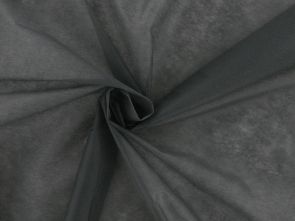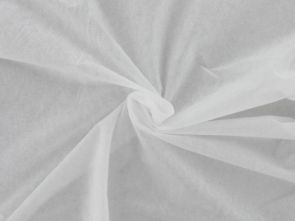Interfacing Fabric
Types of Interfacing: Sew-in vs. Iron-On
There are two main types of interfacing: sew-in and iron-on (fusible). Sew-in interfacing is stitched into the fabric, ideal for when softer support is needed, or when ironing isn’t suitable. Iron-on interfacing has an adhesive side that bonds with the fabric when pressed with heat, making it a quick and convenient option for many sewing projects, where firmer structure is required.
Choosing the Right Weight
Interfacing is available in various weights: lightweight, medium-weight, and heavyweight. Lightweight interfacing is perfect for delicate fabrics like chiffon or silk, where you need subtle support without adding bulk. Medium-weight is the most versatile and is suitable for shirts, dresses, and more structured areas. Heavyweight interfacing is used when you need firm support, ideal for coats, jackets, or handbags that require strong, rigid structure.
Interfacing Materials and Matching to Fabrics
Interfacing comes in woven, non-woven, and knit varieties. Woven interfacing behaves like regular fabric and is best for woven garments, as it allows for a natural drape. Non-woven interfacing has no grain, making it ideal for straightforward cutting and application. Knit interfacing is designed to stretch, making it perfect for use with knit fabrics like jersey, allowing the garment to retain its flexibility while still being supported.
Interfacing for Sheer and Delicate Fabrics
For sheer and delicate fabrics, opt for lightweight interfacing to maintain the garment's fluidity. This ensures that the fabric retains its softness while still gaining some structure. Sheer interfacing is almost invisible and works well with fine fabrics like organza, preventing excess bulk.
Specialist Interfacing Options
Certain projects may require specialist interfacing. Bias-cut interfacing offers flexibility for curved areas, making it ideal for more tailored garments. If you’re working on embroidery or projects where the interfacing is only needed temporarily, water-soluble interfacing is a great choice. It provides stability during the sewing process and can be easily washed away once the stitching is complete.
Eco-Friendly Interfacing
For the environmentally conscious sewer, there are now sustainable interfacing options, such as those made from natural fibres like cotton, or interfacing made with a focus on reducing environmental impact. This allows you to add structure to your projects while staying eco-friendly.
Project-Specific Tips
For different types of projects, there are recommended interfacing options. For dressmaking, a medium-weight iron-on interfacing often provides just the right level of structure. In tailoring, woven sew-in interfacing is a popular choice for a high-quality finish. If you’re making bags or other structured items, heavyweight interfacing is ideal for giving the item a sturdy shape.
How to Apply Interfacing
The application method varies based on the type of interfacing. For sew-in interfacing, pin it to your fabric and stitch along the seams. For iron-on interfacing, place the adhesive side against the fabric and use an iron to press it into place, following the manufacturer’s instructions. To prevent bubbling, use a pressing cloth and apply steady, even heat. Avoid sliding the iron around to prevent misalignment.
Common Mistakes and How to Avoid Them
One of the most common mistakes when using iron-on interfacing is the formation of bubbles. This can happen if the interfacing isn’t applied evenly or if too much heat is used. To avoid this, ensure that you are using a pressing cloth and that the iron is applied evenly, without moving it too much. If bubbling occurs, reheating the area and gently pressing with the cloth can often smooth it out.
Caring for Garments with Interfacing
After applying interfacing, it’s important to follow the care instructions for both the interfacing and the fabric. Iron-on interfacing usually holds up well through washing, but always check that both the fabric and interfacing are compatible with the care methods you're using, ensuring long-lasting durability.







